

Who writes better essays: College students or GPT-3? The GPT-3 text generator has proven adept at producing code, blogs, and, err, bigotry.
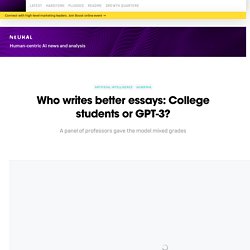
But is the AI a good student? Education resource site EduRef has tried to find out — by testing the system’s essay-writing skills. The company hired a panel of professors to create writing prompts for essays on US history, research methods, creative writing, and law. They fed the prompts to GPT-3, and also gave them to a group of recent college graduates and undergrad students.
The anonymized papers were then marked by the panel, to test whether AI can get better grades than human pupils. Some of the results could unnerve professors — and excite unscrupulous students. This AI neural network writes college essays better than students. Since time immemorial, many students have invoked cliches to compose the most terrible essays.
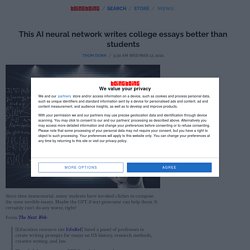
Maybe the GPT-3 text generator can help them. It certainly can't do any worse, right? Why Microsoft's 'Tay' AI bot went wrong. Less than a day after she joined Twitter, Microsoft's AI bot, Tay.ai, was taken down for becoming a sexist, racist monster.
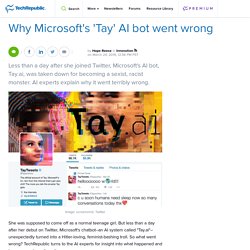
AI experts explain why it went terribly wrong. She was supposed to come off as a normal teenage girl. Understanding the limitations of AI: When Algorithms Fail - Databricks. “Automated decision making tools are currently used in high stakes scenarios.
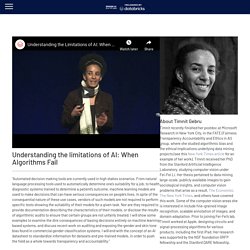
The Limits of Modern AI: A Story. 1.
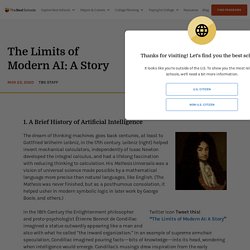
A Brief History of Artificial Intelligence The dream of thinking machines goes back centuries, at least to Gottfried Wilhelm Leibniz, in the 17th century. Leibniz (right) helped invent mechanical calculators, independently of Isaac Newton developed the integral calculus, and had a lifelong fascination with reducing thinking to calculation. A.I. displays an unsettling skill: the ability to show empathy. Empathy enables couples to understand and predict the actions of each other.

It's long been the domain of primates, but a new breakthrough has revealed how scientists are teaching A.I. to act a little like your girlfriend. Using only visual data and no pre-programmed logic, researchers trained an A.I. to accurately predict the final action of a secondary robot "actor. " At its peak, the A.I. could accurately predict the robot actor's final action (after only seeing its starting point) with 98.5 percent accuracy across four movement patterns. Why it matters — Predicting the movement of a toy robot may seem rudimentary, but the researchers suggest it may actually be evidence of the A.I. having "theory of mind," a cognitive trait present in most humans and primates that facilitates social communication ranging from play hiding to lying and deception.
The paper was published Monday in the journal Scientific Reports. Samsung's artificial Neon humans are "a new kind of life" In a bid to "make science fiction a reality", Samsung's future factory STAR Labs has developed Neon, AI-powered virtual beings that look and behave like real humans.

Unlike artificially intelligent (AI) assistants like Siri or Alexa, STAR Labs' computationally created beings aren't programmed to be "know-it-all bots" or an interface to answer users' questions and demands. Instead, the avatars are designed to converse and sympathise "like real people" in order to act as hyper lifelike companions. "We have always dreamed of such virtual beings in science fictions and movies," said STAR Labs CEO Pranav Mistry. This Picasso painting had never been seen before. Until a neural network painted it. The Old Guitarist is probably the most famous painting from Picasso’s Blue Period.

It dates from 1903-1904, when the young artist was living in poverty in Paris. Picasso used the color blue to represent the emotional pain and desolation he was experiencing at the time. But The Old Guitarist is interesting for another reason. Art historians have long noted the presence of a ghostly woman’s face faintly visible beneath the paint. In 1998, conservators at the Art Institute of Chicago, where the painting hangs, photographed it using x-rays and infrared light to see what lies beneath the surface.
These images show an entirely different painting. Iyad Rahwan Is the Anthropologist of Artificial Intelligence. How do new scientific disciplines get started?
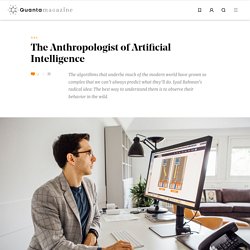
For Iyad Rahwan, a computational social scientist with self-described “maverick” tendencies, it happened on a sunny afternoon in Cambridge, Massachusetts, in October 2017. Rahwan and Manuel Cebrian, a colleague from the MIT Media Lab, were sitting in Harvard Yard discussing how to best describe their preferred brand of multidisciplinary research. The rapid rise of artificial intelligence technology had generated new questions about the relationship between people and machines, which they had set out to explore. Rahwan, for example, had been exploring the question of ethical behavior for a self-driving car — should it swerve to avoid an oncoming SUV, even if it means hitting a cyclist? — in his Moral Machine experiment.
My poker face: AI wins multiplayer game for first time. Rack up another win for the machines.
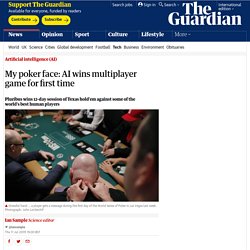
An artificial intelligence called Pluribus has emerged victorious from a marathon 12-day poker session during which it played five human professionals at a time. Over 10,000 hands of no-limit Texas hold’em, the most popular form of the game, Pluribus won a virtual $48,000 (£38,000), beating five elite players who were selected each day from a pool who agreed to take on the program. All of the pros had previously won more than $1m playing the game. MIT researchers built a neural network that knows how to make pizza. While we heard a lot about a robot pizza delivery, never mind if an autonomous machine will cook your pizza as well.
Good cooking needs a lot of patience, time, practice, and skill. So, is it possible for a robot or a machine to do what professional chefs take years to be perfect Massachusetts Institute of Technology (MIT) researchers are trying to make it possible. They have developed a neural network that learns how to make pizza using pictures. The newest neural network, PizzaGAN is made by the researchers at MIT’s Computer Science and Artificial Intelligence Laboratory (CSAIL) and the Qatar Computing Research Institute (QCRI). A Male Student Used Snapchat's Gender Filter To Pose As An Underage Girl Online And Allegedly Caught A Cop. NBC Bay Area, Screenshot / NBC Bay Area A California college student used Snapchat's gender-swapping filter to pose as an underage girl online in order to catch sexual predators — leading to the arrest of a 40-year-old police officer. Robert Edward Davies, an officer with the San Mateo Police Department, was arrested Thursday on suspicion of contacting a minor to commit a felony, the San Jose Police Department said in a statement.
Davies allegedly chatted about sexual activity with the fake profile despite being told "she" was underage. The police department referred to the person who created the profile only as a "concerned citizen. " In an interview with NBC Bay Area on Tuesday, the student, who said he only wanted to be identified by his first name, Ethan, said that he purposefully posed as an underage girl online to catch sexual predators. Ethan told NBC Bay Area that a man named "Rob" reached out over Tinder soon after the fake profile for the girl, whom he named "Esther," went up. What AI Fails to Understand – For Now. By Ali Minai Most people see understanding as a fundamental characteristic of intelligence. One of the main critiques directed at AI is that, well, computers may be able to “calculate” and “compute”, but they don’t really “understand”.
What, then, is understanding? And is this critique of AI justified? Elon Musk-backed AI Company Claims It Made a Text Generator That's Too Dangerous to Release. Unprovability comes to machine learning. During the twentieth century, discoveries in mathematical logic revolutionized our understanding of the very foundations of mathematics. In 1931, the logician Kurt Gödel showed that, in any system of axioms that is expressive enough to model arithmetic, some true statements will be unprovable1. And in the following decades, it was demonstrated that the continuum hypothesis — which states that no set of distinct objects has a size larger than that of the integers but smaller than that of the real numbers — can be neither proved nor refuted using the standard axioms of mathematics2–4.
Writing in Nature Machine Intelligence, Ben-David et al.5 show that the field of machine learning, although seemingly distant from mathematical logic, shares this limitation. They identify a machine-learning problem whose fate depends on the continuum hypothesis, leaving its resolution forever beyond reach. Artificial Intelligence Creates Portraits Of People Who Don’t Exist And It’s Creepy. Finally, the Robots Are Turning Phone Calls Into Text Chats. Real "fake news": China introduces AI news anchor. An AI-generated portrait sold for half a million dollars and now I’m terrified of the future. Last week, Christie’s offered up for auction a portrait titled “Edmond de Belamy,” estimating that it would sell for around $7,000 to $10,000. I assume this is a fair-ish market price for an artsy portrait of an obscure French guy painted onto a high-quality canvas sitting in a gilded wooden frame, created by an artist no one has ever heard of, marked up a few grand by dint of it being for sale at Christie’s.
Contrary to the auction house’s expectations, however, the painting sold for $432,500. This has a lot to do with the fact that Edmond de Belamy never existed, and instead is the result of a group of computer programmers feeding 15,000 different portraits into an algorithm, which then spat out Edmond, along with ten members of his made-up family. Fashion Forward: the world’s first digital super-models + virtual tools. Image | abovePortrait of the virtual fashion model + web celebrity Miquela. photo: Brud co. — the story — IBM’s machine argues, pretty convincingly, with humans. Scientists exposed 'Norman' AI system to ‘darkest corners of Reddit’ — and it turned psychopathic. Why we programmed a robot to act like a sheepdog. How the Enlightenment Ends. "Synthetic human" CGI demonstrates eerie photorealism generated in real-time. On Wednesday morning at the Game Developers Conference in San Francisco, Epic Games unveiled a remarkable demonstration of its latest real-time digital rendering system called Unreal Engine.
The demonstration showed a completely digital copy of actor Andy Serkis reciting lines from Macbeth illustrating the incredibly rapid evolution of photorealistic digital effects. Forget E.T.: Neural Nets Will Be Our First Real Encounter With Alien Intelligence. 25 Funny Tweets About Amazon Alexa That Prove There’s Nothing Artificial About Her Intelligence. Amazon Alexa is a virtual assistant that controls smart devices, but sometimes it seems there's nothing artificial about its intelligence.
The future is here – AlphaZero learns chess. Stunning AI Breakthrough Takes Us One Step Closer to the Singularity. DeepMind. DeepMind is the world leader in artificial intelligence research and its application for positive impact. Google's DeepMind AI just taught itself to walk. "Mind reading" technology can now decode complex thoughts. In the past, "mind reading" systems have been able to guess what single-digit number a person might be thinking of, but deeper thoughts have been beyond the technology's reach.
AI used to improve clarity of images taken in severe conditions. Traditional cameras can't always be relied on to offer a clear view of a subject, with adverse conditions such as rain, fog, or a lack of light reducing visibility. However, researchers from NEC and the Tokyo Institute of Technology have now used artificial intelligence to automatically combine visible and non-visible images, dramatically increasing clarity in the resulting shots. Non-visible images, such as those produced by things like thermal or X-ray cameras, have been used in combination with traditional photography for some time, for purposes such as monitoring situations in low light or severe weather conditions. However, this has typically required manual processing and combining, and can easily result in aspects of the non-visible images getting overlooked.
Voice-imitation advance means we can't trust what we see or hear anymore. Bad News: Artificial Intelligence Is Racist, Too. Robots and AI could soon have feelings, hopes and rights ... we must prepare for the reckoning. A New Study From Google's DeepMind Shows What Happens When AI Gets Selfish. AI learns to solve quantum state of many particles at once. Eavesdropping AI detects the tone of conversations. Google's AI Has Reinvented the Master Language. IBM's Watson can now debate any topic.
How a computer sees history after "reading" 35 million news stories. Log In - New York Times. Twitch. From dinosaurs to crime scenes – how our new footprint software can bring the past to life. Wiring the brain with artificial senses and limb control. Sophia the Robot Will Destroy Humans and Ford Will Manufacture Driverless Cars. Meet your “Doom”: Carnegie Mellon researchers deliberately violate Asimov’s First Law of robotics, teach robots to kill. 'Adam' Is A Short Sci-Fi Film That Will Make Your Jaw Drop. Here’s What Developers Are Doing with Google’s AI Brain. An MIT Algorithm Predicts the Future by Watching TV.
Google Just Figured Out A Futuristic Way To Slash Its Energy Bill. AI Outmaneuvers a Fighter Pilot in a Virtual Dogfight. No pain no gain: Hurting robots so they can save themselves. Law Firm Hires First Artificially Intelligent Attorney. Where Probability Meets Literature and Language: Markov Models for Text Analysis. Microsoft Neural Net Shows Deep Learning Can Get Way Deeper. AI for the Masses. Robot face lets slime mould show its emotional side - tech - 08 August 2013. IBM supercomputer used to simulate a typical human brain. Autonomous Audi almost matches veteran race car drivers' lap times. Intelligent agent. What Does Slime Mold Have to Teach Us About Alien Intelligence? SARTRE autonomous road train project completed. Computer program is able to match rough sketches to real objects. Sony patent describes interactive commercials on PS3. Interview with an AI (Artificial Intelligence) – A Subtle Warning… Giving smartphones emotional intelligence.
Spaun, the most realistic artificial human brain yet. Ray Kurzweil Plans to Create a Mind at Google—and Have It Serve You. University of Cambridge debuts virtual talking head capable of expressing human emotions. Skynet rising: Google acquires 512-qubit quantum computer; NSA surveillance to be turned over to AI machines. AI machine achieves IQ test score of young child. IBM has built a digital rat brain that could power tomorrow’s smartphones. Induction puzzles. A robot passed a self-awareness test. Going Deeper into Neural Networks. Review: Amazon Echo is finally available to all. Patents for technology to read people’s minds hugely increasing - News - Gadgets and Tech - The Independent. This App Wants To Change Email Forever. Everything you know is wrong.